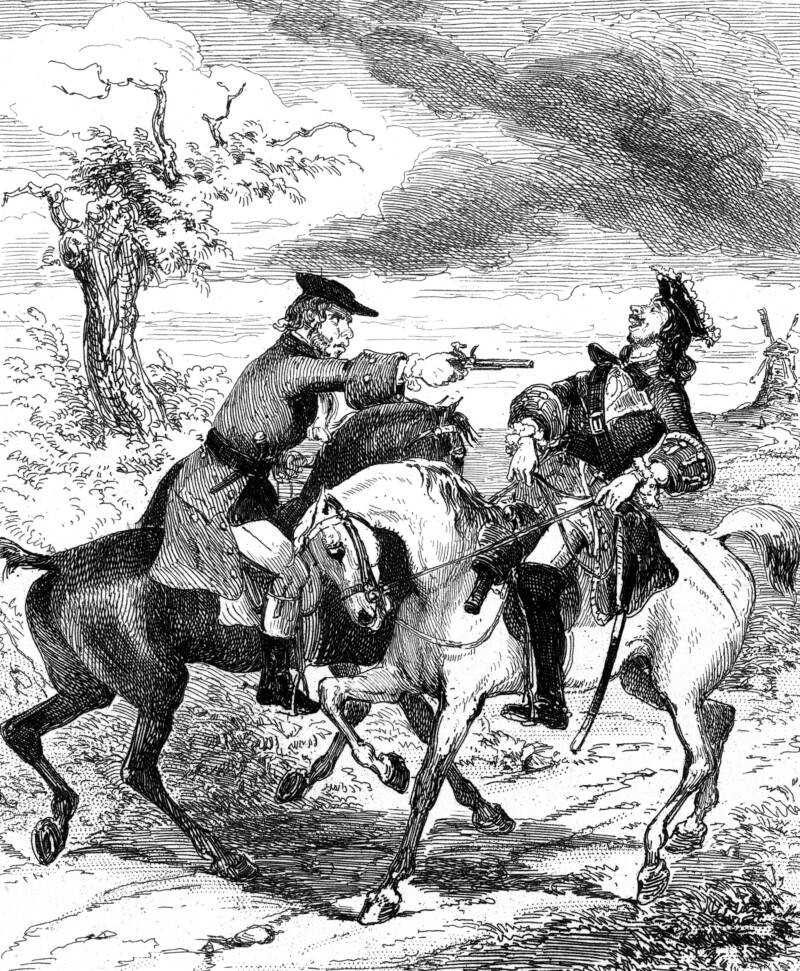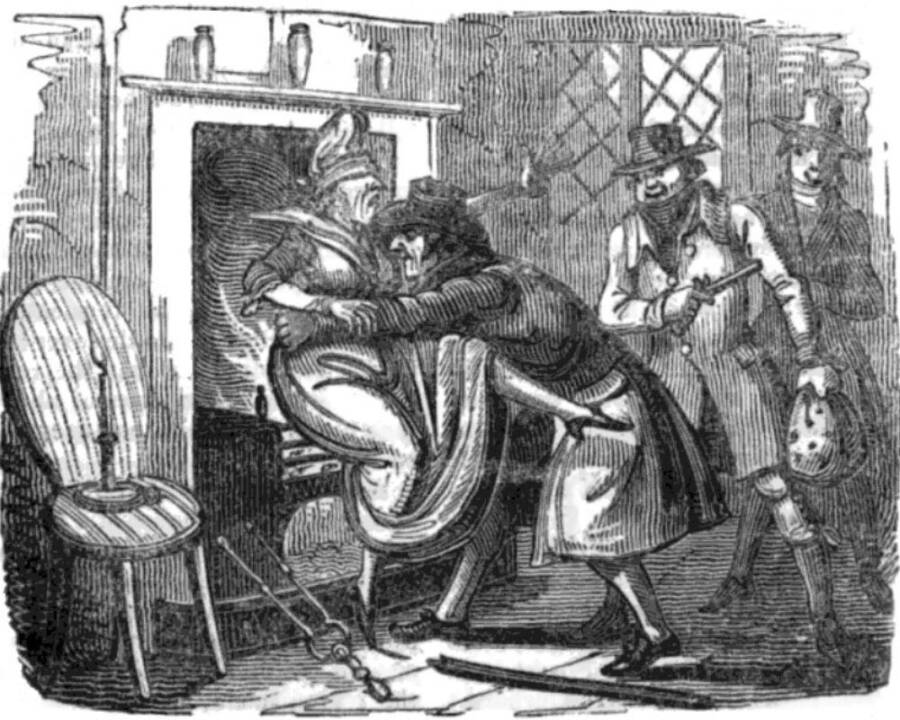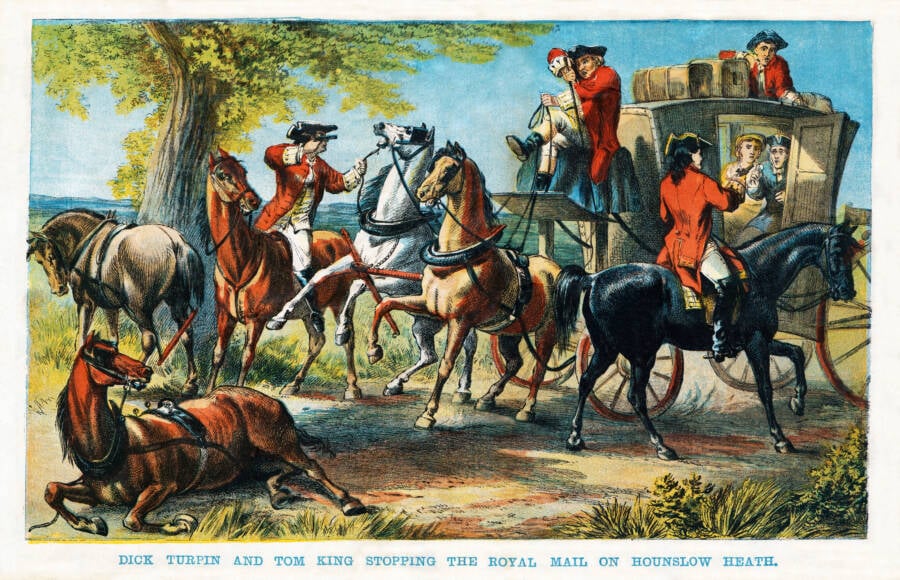Although Dick Turpin's exploits were later romanticized in plays and serial fiction, in reality, he was a ruthless criminal who terrorized England in the early 18th century.

World History Archive / Alamy Stock PhotoDick Turpin was a notorious highwayman who terrorized the roads from London to York in the early 18th century.
Dick Turpin was an 18th-century English highwayman whose exploits became famous almost 100 years after he was executed for horse theft. The romanticized image of Turpin as a Robin Hood figure is largely a myth perpetuated by works of fiction — but that hasn’t stopped authors and playwrights from idolizing the career criminal for centuries.
In reality, Turpin was a brutal thief who later turned to highway robbery after escaping punishment for his early crimes. The law eventually caught up to him, and he was hanged in 1739, but his notorious reputation was immortalized in fictional tales that instead painted him as a dashing folk hero.
In 1834, English author William Harrison Ainsworth wrote Rookwood, a Gothic romance novel about a wealthy family fighting over an inheritance. Dick Turpin makes an appearance in the story as a captivating highwayman who leads a thrilling overnight chase from London to York on his horse, Black Bess.
However, Black Bess wasn’t really the name of Turpin’s horse — and the highwayman never actually made such a ride. Dick Turpin wasn’t the charming rogue of legend. He was, in fact, just the opposite. This is his true story.
The Early Life Of Dick Turpin
Richard “Dick” Turpin was born in Essex in 1705. His father was a butcher who likely trained young Turpin to follow in his footsteps.
Unlike the literature that painted him as handsome and charismatic, Turpin’s reality was much different. A 1737 edition of The Gentleman’s Magazine described him: “Turpin was born at Thackstead in Essex, is about Thirty, by Trade a Butcher, about 5 Feet 9 Inches high, brown Complexion, very much mark’d with the Small Pox, his Cheek-bones broad, his Face thinner towards the Bottom, his Visage short, pretty upright, and broad about the Shoulders.”

Public DomainA Victorian-era penny dreadful featuring Dick Turpin.
It was probably Turpin’s career choice that led to his involvement with a group of local deer poachers known as the Gregory Gang or the Essex Gang in the mid-1730s. The criminals would have needed someone to help them break down and sell their illegally obtained game, and Turpin had all the right connections.
Soon, however, the gang moved on from poaching and started carrying out more serious crimes.
The Violent Crimes Of The Gregory Gang
In October 1734, the Gregory Gang robbed the shop of a grocer — and it was rumored that Dick Turpin was among them. And that December, Turpin and five accomplices stole the equivalent of more than $50,000 in today’s currency from a local farmer. The Gregory Gang ransacked houses, threatened people with guns, and grew ever more violent as the months went on.
In February 1735, Turpin met several of his fellow gang members at an inn in London, where they plotted their crimes against their next victim: Joseph Lawrence, a 70-year-old farmer in Edgware.
When they arrived at his home later that evening, they first tied up his maids, raping at least one of the women. The men then brutally attacked Lawrence, but he refused to reveal where his money was hidden. Turpin reportedly poured boiling water over the elderly man’s head, beat his bare buttocks with a pistol, made him sit in fire, and dragged him around the house by his nose until he finally gave in.
However, the most notorious crime Turpin was linked to was the attack on a woman known as Widow Shelley. The Gregory Gang terrorized her and her son at their home in Loughton. They threatened them with violence and told her they would push her into the fireplace and kill her if she didn’t reveal where she’d stashed her money.

The Newgate Calendar/Wikimedia CommonsAn illustration of Dick Turpin pushing Widow Shelley into the fire, 1824.
She refused to tell them anything, but her son, fearful for his mother’s life, gave the gang the location of their life savings.
When the authorities finally caught up with the gang in early 1735, many of its members faced execution, but Turpin managed to escape and turned to a new profession: highway robbery.
Dick Turpin’s Life As A Highwayman
Dick Turpin soon joined up with notorious criminal Tom King. Together, they operated from a cave in Epping Forest near London and targeted traveling pedestrians. Before long, a large bounty was placed on their heads.
However, their criminal journey took a tragic turn on May 2, 1737, when a robbery went awry and Turpin shot King while attempting to fire at the constable. King passed away from his injuries on May 19, 1737, according to The History Press. Turpin had accidentally killed his accomplice.

Lordprice Collection / Alamy Stock PhotoDick Turpin and Tom King robbing a Royal Mail coach.
Turpin now found himself alone, with most of his friends either dead or imprisoned. Following King’s death, he returned to Epping Forest. There, a man named Tom Morris, a gamekeeper’s servant, recognized Turpin as a wanted outlaw. Morris foolishly confronted him alone and tried to apprehend him — so Turpin shot and killed him.
Turpin changed his name to John Palmer and fled to Yorkshire, not with a daring ride, but simply by taking a ferry. However, his attempts to hide were unsuccessful, and he was arrested on Oct. 2, 1738, after shooting a rooster and threatening its owner.
From his cell, “Palmer” wrote to his brother-in-law asking for help. But one of Turpin’s former schoolmates worked at the post office. He recognized the highwayman’s handwriting, as he had been the one to teach Turpin to write in school. He quickly turned Turpin in for a substantial reward.
The Death Of The Highwayman And His Romanticized Legacy
In March 1739, Dick Turpin was sentenced to death in York. However, he remained cheerful, entertaining frequent visitors and even purchasing new clothes and shoes for his execution.
The day before he was set to be hanged, Turpin paid five men 14 shillings each to mourn him publicly. The day of his execution, he reportedly “behav’d himself with amazing assurance” and “bow’d to the spectators as he passed” on the way to the gallows. He died on April 7, 1739, at the age of 33.
An account in The Gentleman’s Magazine that same month noted that “Turpin behaved in an undaunted Manner; as he mounted the Ladder, feeling his right Leg tremble, he stamp’d it down, and looking round about him with an unconcerned Air, he spoke a few Words to the Topsman, then threw himself off, and expir’d in five Minutes.”

Public Domain/Wikimedia CommonsA poster for a 1925 film portraying Dick Turpin as a romantic hero.
While Turpin was romanticized in English folklore and falsely portrayed as a charismatic and daring outlaw, he was certainly no Robin Hood. The exact details of his life and exploits have often been blurred with fiction and legend as his story has been embellished over the years. Turpin is remembered in literature and popular culture as the hero he never was.
In fact, his life and crimes may have been forgotten to time if it weren’t for Ainsworth’s novel. However, after Rookwood was published, a romanticized version of Turpin’s life began appearing in serial fiction, ballads, plays, and later even silent films. Most recently, Apple TV+ has produced The Completely Made-Up Adventures of Dick Turpin, carrying on the highwayman’s legacy nearly 300 years after his death.
After reading about the legendary highwayman Dick Turpin, discover the story of Bonnie and Clyde, the iconic 20th-century outlaws who were immortalized in literature and film. Then, learn about the myth of American frontier legend Jesse James.





